
Is this an aquatic weed? Identifying the plants in your pond
Invasive aquatic weeds are non-native species that spread rapidly, threatening the diversity and abundance of native plant species and the ecological balance of lakes and ponds. In addition to reducing the habitat quality for aquatic life, invasive water weeds can limit the recreational use of waterbodies for activities like boating, fishing, and swimming. They can also impede the functionality of stormwater ponds by clogging inlet and outlet structures which can lead to potential flooding risks. Not to mention, invasive water weeds can quickly become eyesores and diminish the beauty of a property.
However, most types of invasive aquatic weeds are not inherently bad, but they can spread aggressively, disrupting ecological balances which can threaten the entire food web. Even native vegetation can become a nuisance to waterbody owners and managers depending on their management goals. Invasive aquatic weeds can be very difficult to control, which is why it is important to detect them early and begin a lake management program before they have a chance to take over your waterbody.
How do invasive aquatic weeds spread?
Aquatic weed identification is broken down into three main categories: submerged, emergent, and floating. These invasive aquatic weeds are spread primarily through human activities, animals, and natural ecological processes. Activities such as boating and fishing can introduce non-native species into new environments. Boats, trailers, fishing gear, and even the water in boat engines can carry plant fragments from one body of water to another. Animals like birds and domestic livestock can also contribute to the spread of invasive weeds. Seeds or plant fragments can attach to the bodies of animals or their feathers and fur, transporting these invasive weeds to new locations as the animals move across different water sources. Natural weather events like flooding, rainstorms, and wind can also transport seeds and plant fragments into new environments, allowing for the rapid spread of invasive pond weeds. Ornamental plant trading has also led to the introduction of non-native plants into North American waterways.
There are many types of invasive aquatic weeds, here are the most common types lake and pond owners deal with:
Submerged waterbody plants
Submerged plants grow under the water’s surface and sometimes “top out” above the water line. Their dense growth can cause problems for boating, fishing, and aquatic life. Invasive submerged water weeds include:

Hydrilla
Hydrilla is a freshwater aquatic weed recognized for its long, slender stems and whorled leaves. It’s native to Asia and has spread to every region except Antarctica. Hydrilla’s unique physiological and reproductive traits have earned it the nickname “The Perfect Aquatic Weed,” meaning it can be especially hard to control. Its adaptability allows this water weed to dominate waterbodies outside its native habitat, outcompeting native plants and easily moving through different ecosystems.

Egeria (Brazilian Elodea)
Egeria is native to warm, freshwater habitats in southeastern Brazil. It is characterized by its bright green color, bushy appearance, and long, slender stems that can grow several inches in length. Outside of its natural habitat, this aquatic plant can become aggressively invasive. Due to its rapid growth and high reproduction rate, it outcompetes local species for light and nutrients, often forming dense mats that obstruct waterways and affect water quality.

Curlyleaf Pondweed
Curlyleaf pondweed is a submerged aquatic weed characterized by its wavy-edged, oblong leaves. This type of aquatic weed is originally found in parts of Eurasia, Africa, and Australia but has become invasive in parts of North America. It grows in the late fall and early spring before most native plants, allowing it to take root quickly and create a surface mat that deprives other plants and aquatic life of oxygen.

Eurasian Watermilfoil
Eurasian watermilfoil is native to Europe and was introduced to the United States in the early 1900s. This type of aquatic plant has feather-like leaves and can thrive in a variety of ecosystems. Its lack of natural predators allows it to grow rapidly, clog waterways, and alter aquatic environments.
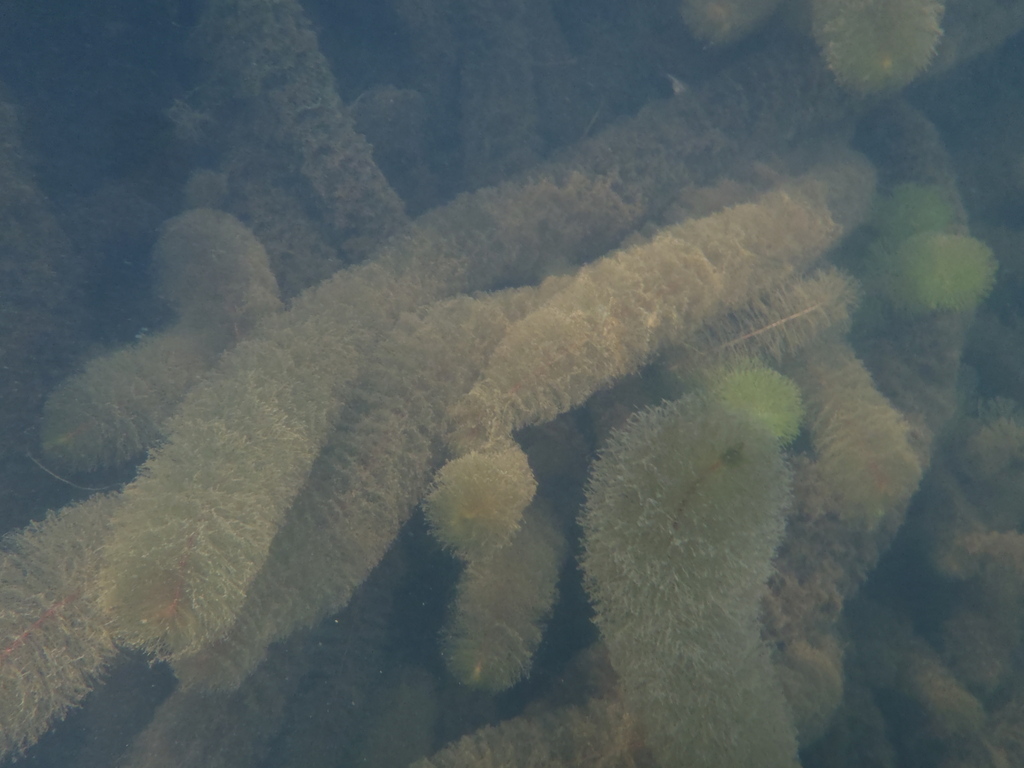
Variable Milfoil
Variable milfoil is native to parts of the Midwest and Southeast United States. Its thick, feather-like leaves often resemble a pipe cleaner or a raccoon tail. This pond weed can be invasive due to its rapid growth rate and ability to spread quickly, which can lead to dense mats that choke out native aquatic plants, disrupt water flow, and negatively impact aquatic life.
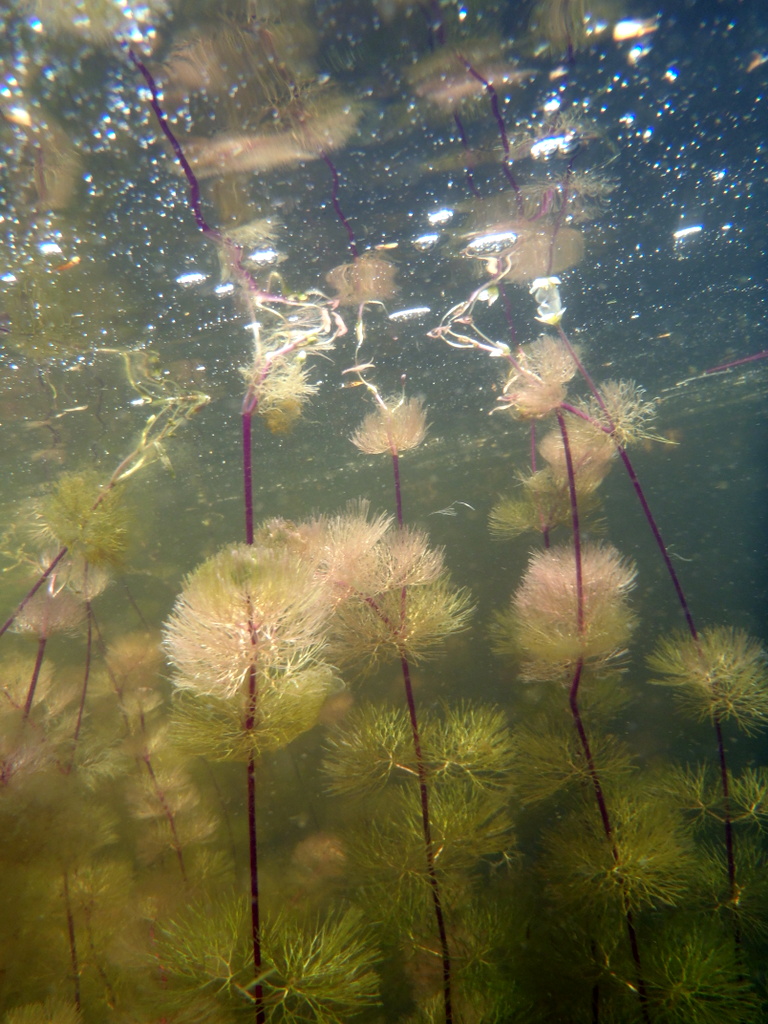
Fanwort
Fanwort is native to the Southern United States and South America. Thriving in still or slow-moving waters, it forms mats that disrupt aquatic ecosystems. It is extremely dense and has delicate stems that can easily fragment and re-sprout in both high-nutrient and low-nutrient waterbodies. This aquatic weed’s rapid growth outcompetes native vegetation and alters habitat structures.
Emergent pond plants
Emergent plants grow in shallow water, with the majority of the plant standing upright above the water. They create complex root systems that can quickly dominate shorelines, outperform native vegetation, and harm marsh and wetland areas. Invasive emergent pond weeds include:
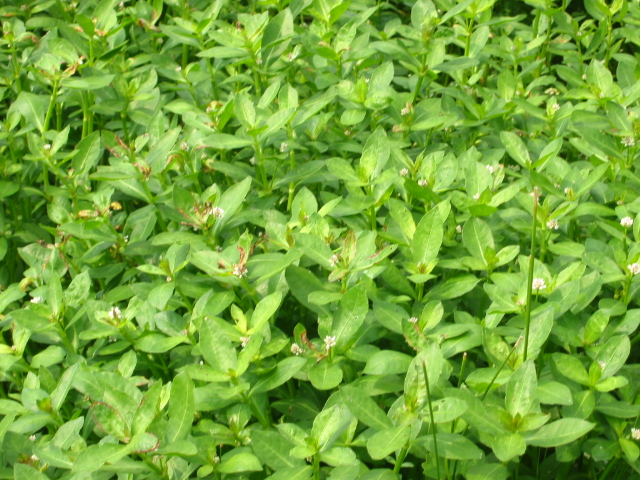
Alligatorweed
Alligatorweed is a perennial aquatic plant native to South America. It is known for its thick, mat-forming growths, which can dominate waterways. This type of aquatic weed can be identified by its elliptical or lanceolate leaves with smooth margins arranged in opposite pairs along the shoots and white flowers. Its lack of predators allows it to go unchecked, which has led to significant ecological damage throughout the Southern United States.

Smartweed
Smartweed is known for its lance-shaped leaves and spikes of pink or white flowers. Native to Europe and parts of North America, it thrives in damp environments and is often found in agricultural fields, gardens, and along waterways. Smartweed’s invasive nature is attributed to its high seed production, ability to adapt to various environments, and ability to regrow from small fragments, allowing this pond weed to spread aggressively and take over waterbodies.
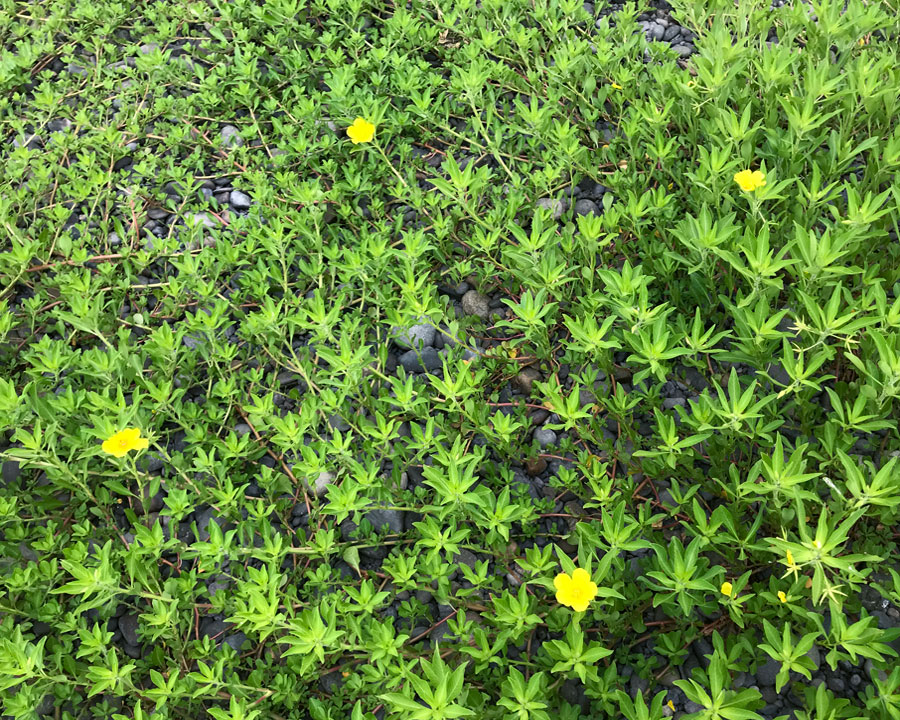
Water Primrose
Water primrose, with its vibrant yellow flowers, thrives in wet habitats. Although it may appear to add beauty to your waterbody, it is actually invasive outside of its native environment of South America. It forms dense mats that obstruct water flow and can harm water quality and aquatic life. This type of aquatic weed‘s adaptability to various aquatic environments, coupled with its high reproduction rate, makes it challenging to control.
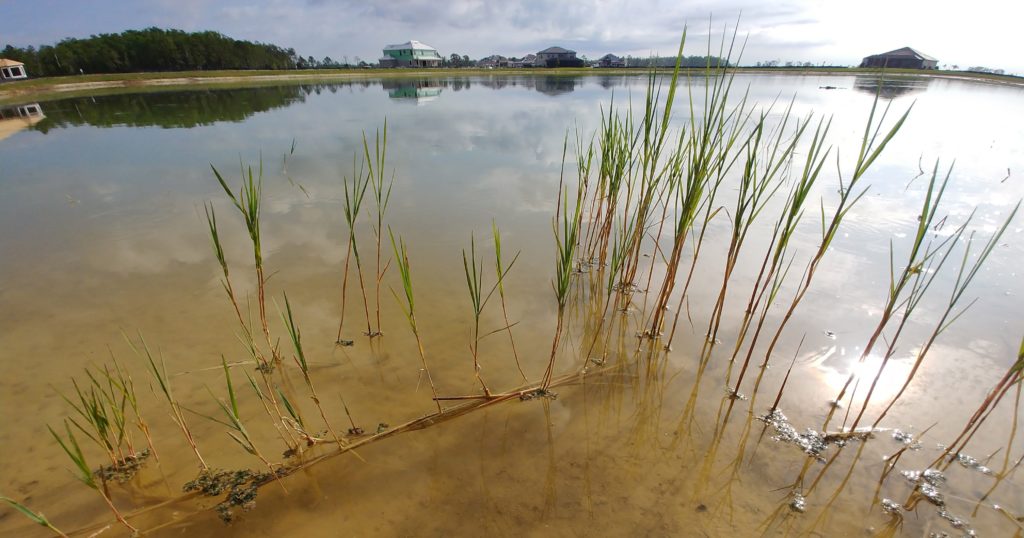
Torpedograss
Torpedograss, also known as quack grass and bullet grass, is native to Asia and Africa but has invaded parts of North America. It can grow in a variety of environments, forming extensive root systems that impact aquatic life and beneficial vegetation. This water weed is commonly identified by its rhizomatous root structure and rigid, sharp-pointed (torpedo-like) tips. Its upper leaf sheaths can have hairs on their upper edges, while its lower half has long hairs near the base.
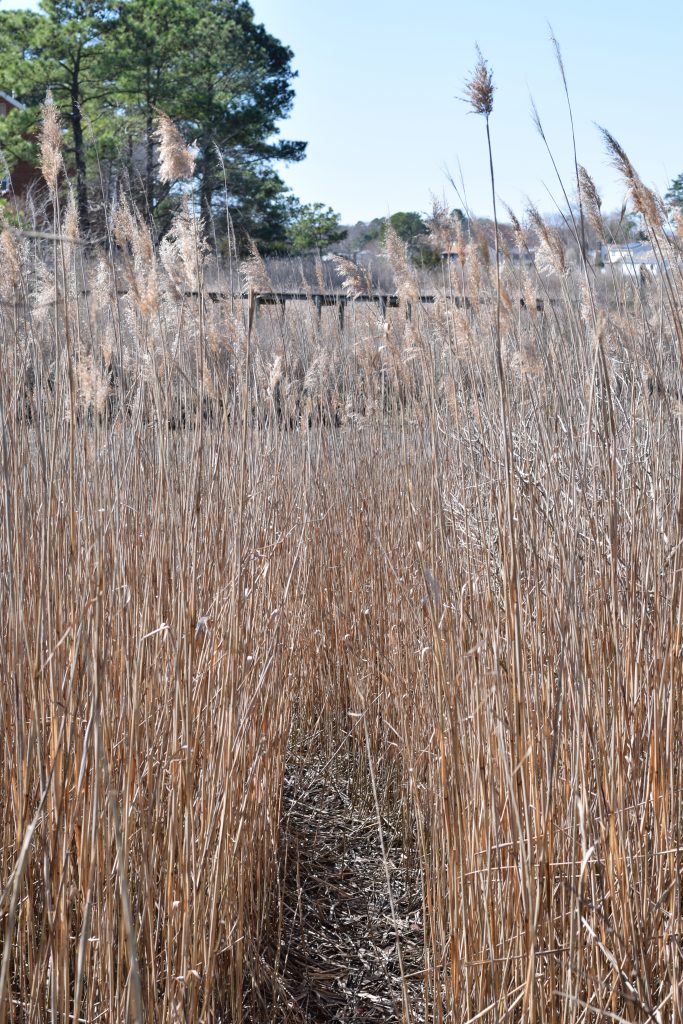
Phragmites
Phragmites, also known as the common reed, is a tall, perennial grass with feathery flower plumes and a widespread root system. This type of aquatic plant thrives in wetlands, along riverbanks, and in other moist environments. Phragmites can grow up to 16 feet tall and form impenetrable monocultures. They can create complex root systems that dominate large areas, making them difficult to control.
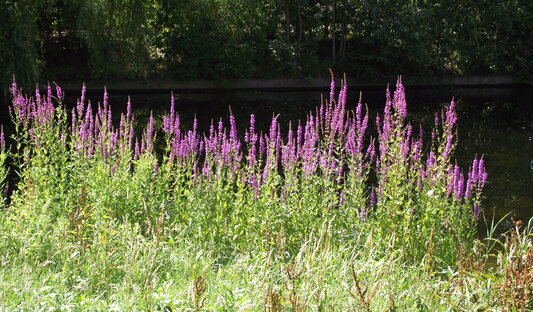
Purple Loosestrife
Purple loosestrife has spikes of purple flowers that bloom in summer. Originating from Europe and Asia, it has become invasive in many parts of North America. Its robust root mass will survive even after the top is completely removed, making control difficult. In natural wetlands, this water weed outcompetes native plants, reducing biodiversity.
Floating lake plants
Floating plants have vascular root systems and have most of their leaves and plant tissue floating on top of the water. They can spread rapidly throughout your lake or pond and can completely cover the water’s surface. Invasive floating aquatic weeds include:
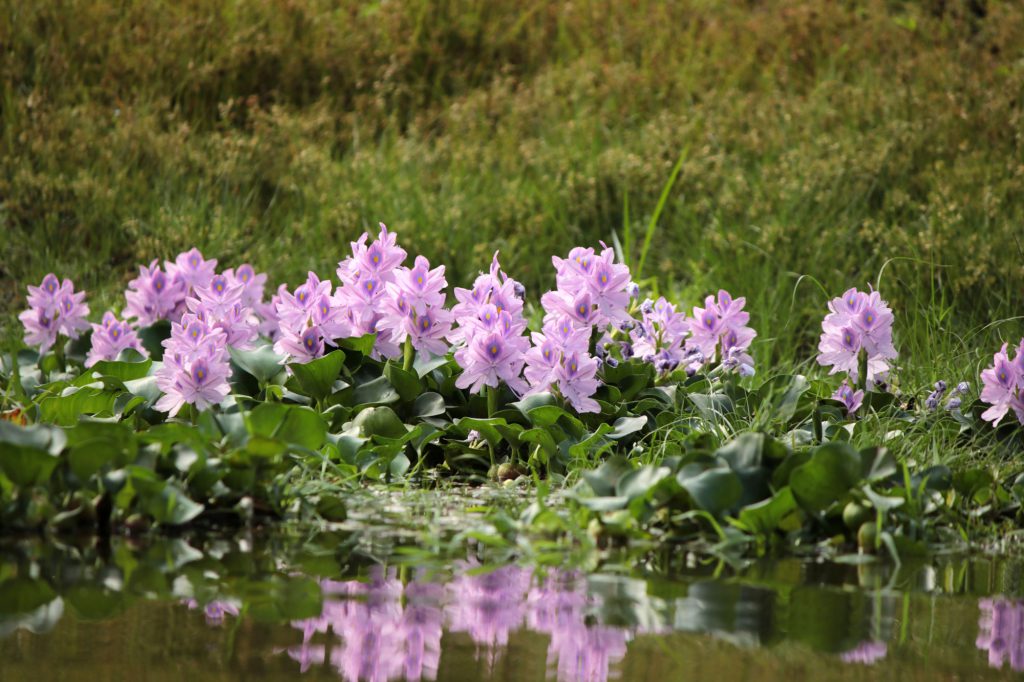
Water Hyacinth
Water Hyacinth is a floating aquatic weed with broad, glossy leaves and striking purple flowers. It is native to the Amazon basin in South America, and its rapid growth rate and ability to form dense mats on water surfaces enable it to outcompete native species. If left untreated, water hyacinth can disrupt water flow and deplete oxygen levels, potentially harming other aquatic species.
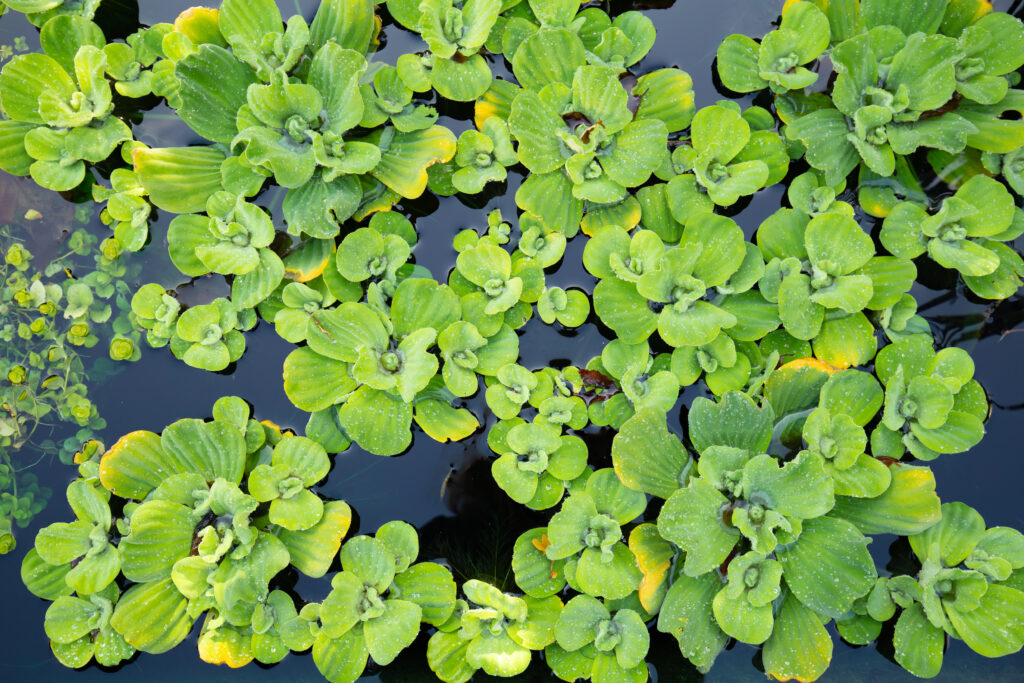
Water Lettuce
Water lettuce has soft, pale green leaves that form a rosette, resembling an open head of lettuce. This pond weed thrives in still or slow-moving waterbodies, creating runners that obstruct sunlight and oxygen exchange. It’s native to tropical and subtropical regions and can clog waterways, making it difficult and nearly impossible to access the water for recreational activities.
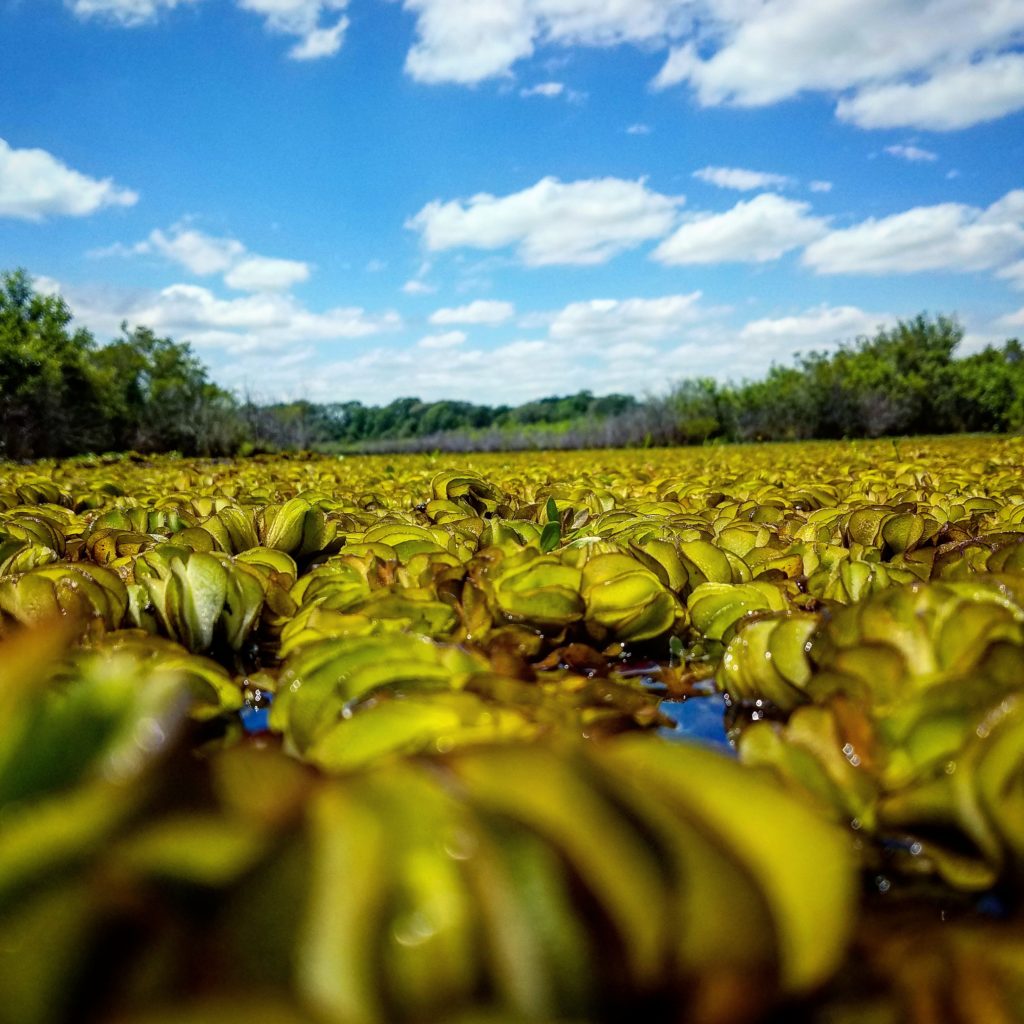
Giant Salvinia
Giant salvinia is a free-floating, clustered aquatic weed known for its rapid growth and ability to disrupt ecosystems. They contain chain-like oblong leaves with sharp hairs that form thick, floating canopies that block out sunlight. Native to South America, it can quickly grow out of control and has been found in several states across the United States, including Texas, California, Arizona, and Florida.
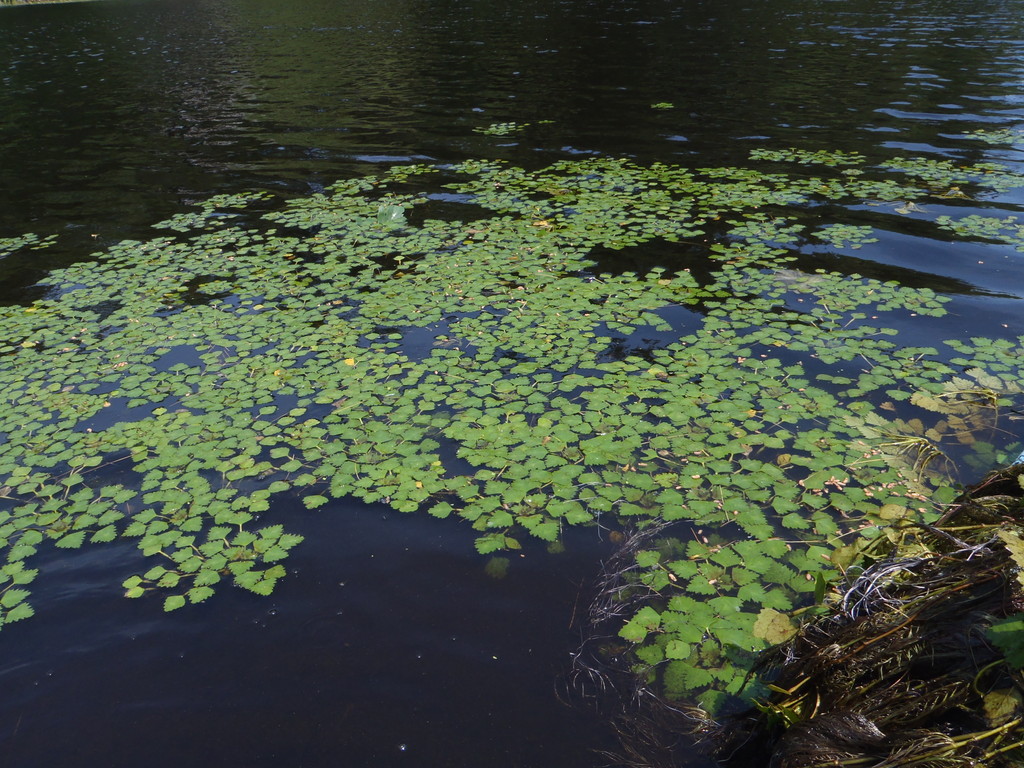
Water Chestnut
Water chestnut has distinctive, diamond-shaped leaves that form a rosette on the water’s surface. Its underwater stem can be several meters long, and it produces a spiky, nut-like fruit. Native to Eurasia and Africa, this pond weed was introduced to North America in the mid-1800s as an ornamental plant. This invasive plant spreads rapidly, forming dense mats that hinder water flow, block sunlight, and deplete oxygen. Its ability to reproduce from seeds that can remain viable for up to 12 years makes managing its spread challenging.
Managing invasive aquatic weeds in ponds
Once aquatic weed identification is complete, small-scale selective treatments can be implemented to contain and eliminate the species if detected early. Monitoring is also an important element of an effective invasive aquatic weed management program. Regular inspections allow us to identify and control any nuisance pond weeds before they have a chance to spread.
For large open areas or sites where land or boat-based aquatic treatments are a challenge, we offer aerial application technologies, allowing you to control all types of aquatic weeds. Aerial applications are often much more efficient and cost-effective in these situations. We also provide mechanical harvesting, hydro-raking, and EPA-registered herbicides.
Invasive aquatic weeds should be managed quickly and effectively by professionals. Controlling these harmful water weeds will help restore balance to your aquatic ecosystem and create a safe environment for fishing, boating, swimming, and aquatic life.
Pond Weed Management Tips
SOLitude Lake Management is a nationwide environmental firm committed to providing sustainable solutions that improve water quality, enhance beauty and preserve natural resources.
SOLitude’s team of aquatic scientists specializes in the development and execution of customized lake, stormwater pond, wetland and fisheries management programs. Services include water quality testing and restoration, algae and aquatic weed control, installation and maintenance of fountains and aeration systems, shoreline erosion control, muck and sediment removal and invasive species management. SOLitude partners with homeowners associations, golf courses, private landowners, businesses and municipalities. SOLitude Lake Management is part of Rentokil, a leading business services company, operating across the United States, Canada and Puerto Rico.
For more information, visit SOLitude Lake Management at solitudelakemanagement.com, and connect on Facebook, LinkedIn, Twitter, Instagram and YouTube.









